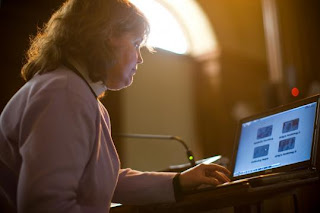 Michael Paulson of The Boston Globe reports on Episcopal priest Anne E. Gardner, who is chaplain at the Phillips Academy in Andover, MA. She uses a variety of media to enhance liturgy and connect Christianity with everyday living.
Michael Paulson of The Boston Globe reports on Episcopal priest Anne E. Gardner, who is chaplain at the Phillips Academy in Andover, MA. She uses a variety of media to enhance liturgy and connect Christianity with everyday living.Paulson writes:
The key to success is not to use the material to appear to be cool and it certainly cannot be seen as a gimmick to fill pews with young people. For this to work, music and media clips must connect the content of Christianity with everyday concerns using idioms the audience is familiar with. Also, the preacher must be prepared for a more interactive experience: instead of the preacher simply speaking to a passive congregation, the preacher is presenting the sermon in an environment that will be a certain degree interactive. We must assume that the people we are meeting from the pulpit are willing and able to engage the content of the Christian faith.Last Sunday, the first of Lent, Gardner preached to her mostly adolescent congregation about the challenges of forgiveness, projecting onto a large screen clips from YouTube of India.Arie singing "The Heart of the Matter," by Don Henley, as well as two clips from "Grey's Anatomy," in which Callie and George (played by Sara Ramirez and T.R. Knight) talk about whether she can forgive him for cheating on her. Gardner also aired a clip from "Good Will Hunting" in which a psychologist played by Robin Williams tries to persuade the genius MIT janitor played by Matt Damon that he is not to blame for being abused by his foster father; and a scene from "Ordinary People" in which a therapist played by Judd Hirsch tries to persuade a teen played by Timothy Hutton to forgive himself after surviving an accident in which his brother was killed and then attempting suicide.
"It allows me to speak to them in their own vernacular and it also allows me to expand the message of the Bible well past the four walls of our sanctuary," Gardner said. "The core concept is not to criticize contemporary culture but rather to highlight that messages we receive through everyday living in newspapers, music, and the like can help us find our way into living ethical, just, and compassionate lives."
Another key for multi-media to work in worship is comfort. Both the preacher and the congregation must be comfortable with the technology. The congregation must look past its presence to comprehend what is being communicated. The preacher must be at home enough so that she picks relevant choices, uses it well with a minimum of technical interuption (IE minimal stopping to set up and take down) and is practiced enough to put together the material smoothly.Gardner is the chaplain for all Protestants, so some of the worshipers have previously experienced experimentation with technology in evangelical megachurches.
"Included in nearly every sermon at my church is a PowerPoint presentation which often incorporates scenes from movies or the news or television, etc.," said Rachel Coleman, a Baptist from Manchester, Maine. "While my own church's clips have never contained profanity, I do not think this detracted from the message; rather, it made it more pressing and real."
The most important lesson from Gardner's work is that whatever medium the preacher uses, the preacher must take her hearers seriously, assume that they are willing to engage the material, and that they are not willing to just passively take it but wish to engage in dialogue and do the work of integrating what they have learned into their living.Others, particularly those from highly liturgical mainline Protestant denominations, have not previously seen multimedia worship services and some have no previous experience with church services of any kind.
"At first I thought the iSermons were going to be a little cheesy, just because trying to modernize things doesn't often work out well," said Kevin Ofori, a 17-year-old Episcopalian from Wooster, Ohio. "But after the first one I realized that Rev. Gardner wasn't just trying to connect with us by using modern lingo. She really knows how to use modern media to cement biblical virtues as relevant in our day and age."
Read the rest here.
See also the Episcopal Cafe here.
H/T to DioBeth newSpin.



No comments:
Post a Comment